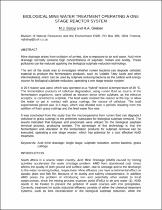JavaScript is disabled for your browser. Some features of this site may not work without it.
- ResearchSpace
- →
- Research Publications/Outputs
- →
- Conference Publications
- →
- View Item
| dc.contributor.author |
Baloyi, MJ

|
|
| dc.contributor.author |
Greben, HA

|
|
| dc.date.accessioned | 2009-01-21T09:57:59Z | |
| dc.date.available | 2009-01-21T09:57:59Z | |
| dc.date.issued | 2006-05 | |
| dc.identifier.citation | Baloyi, MJ and Greben, HA. 2006. Biological mine water treatment operating a one stage reactor system. Water Institute of South Africa Conference: Durban 21-24 May 2006, pp 9 | en |
| dc.identifier.uri | http://hdl.handle.net/10204/2873 | |
| dc.description.abstract | Mine drainage arises from oxidation of pyrites, due to exposure to air and water. Acid mine drainage normally contains high concentrations of sulphate, metals and acidity. These pollutants can be reduced by applying the biological sulphate reduction technology. The aim of this study was to investigate whether rumen bacteria can degrade cellulytic material to produce the fermentation products, such as Volatile Fatty Acids and other intermediates, which can be used by sulphate reducing bacteria as the carbon and energy source for biological sulphate reduction, operating a one stage reactor system. A 20 litre reactor was used, which was operated as a “hybrid” reactor at temperature of 39 °C. The fermentation products of cellulose degradation, using rumen fluid as source of the fermentation organisms, were utilised as electron donor when sulphate, as the electron acceptor, is converted to sulphide. The feed water entered the reactor at the top, to allow the water to get in contact with grass cuttings, the source of cellulose. The total experimental period was 113 days, which was divided over 4 periods resulting from the addition of fresh grass cuttings and the feed water flow rate. It was concluded from this study that the microorganisms from rumen fluid can degrade t cellulose in grass cuttings to the preferred substrates for biological sulphate removal. The results indicated that butyrate and propionate were utilized for the biological sulphate removal process, producing acetate | en |
| dc.language.iso | en | en |
| dc.subject | Acid mine drainage | en |
| dc.subject | Sulphate reduction | en |
| dc.subject | Rumen bacteria | en |
| dc.subject | Grass cuttings | en |
| dc.subject | Coal mines | en |
| dc.subject | South Africa | en |
| dc.title | Biological mine water treatment operating a one stage reactor system | en |
| dc.type | Conference Presentation | en |
| dc.identifier.apacitation | Baloyi, M., & Greben, H. (2006). Biological mine water treatment operating a one stage reactor system. http://hdl.handle.net/10204/2873 | en_ZA |
| dc.identifier.chicagocitation | Baloyi, MJ, and HA Greben. "Biological mine water treatment operating a one stage reactor system." (2006): http://hdl.handle.net/10204/2873 | en_ZA |
| dc.identifier.vancouvercitation | Baloyi M, Greben H, Biological mine water treatment operating a one stage reactor system; 2006. http://hdl.handle.net/10204/2873 . | en_ZA |
| dc.identifier.ris | TY - Conference Presentation AU - Baloyi, MJ AU - Greben, HA AB - Mine drainage arises from oxidation of pyrites, due to exposure to air and water. Acid mine drainage normally contains high concentrations of sulphate, metals and acidity. These pollutants can be reduced by applying the biological sulphate reduction technology. The aim of this study was to investigate whether rumen bacteria can degrade cellulytic material to produce the fermentation products, such as Volatile Fatty Acids and other intermediates, which can be used by sulphate reducing bacteria as the carbon and energy source for biological sulphate reduction, operating a one stage reactor system. A 20 litre reactor was used, which was operated as a “hybrid” reactor at temperature of 39 °C. The fermentation products of cellulose degradation, using rumen fluid as source of the fermentation organisms, were utilised as electron donor when sulphate, as the electron acceptor, is converted to sulphide. The feed water entered the reactor at the top, to allow the water to get in contact with grass cuttings, the source of cellulose. The total experimental period was 113 days, which was divided over 4 periods resulting from the addition of fresh grass cuttings and the feed water flow rate. It was concluded from this study that the microorganisms from rumen fluid can degrade t cellulose in grass cuttings to the preferred substrates for biological sulphate removal. The results indicated that butyrate and propionate were utilized for the biological sulphate removal process, producing acetate DA - 2006-05 DB - ResearchSpace DP - CSIR KW - Acid mine drainage KW - Sulphate reduction KW - Rumen bacteria KW - Grass cuttings KW - Coal mines KW - South Africa LK - https://researchspace.csir.co.za PY - 2006 T1 - Biological mine water treatment operating a one stage reactor system TI - Biological mine water treatment operating a one stage reactor system UR - http://hdl.handle.net/10204/2873 ER - | en_ZA |






